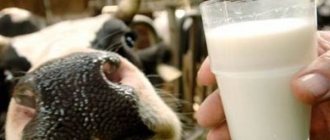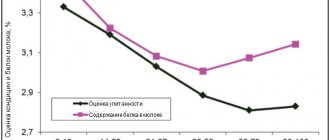Sheep have been bred for milk for thousands of years. Perhaps even before people started milking cows. In the modern world, dairy sheep farming is concentrated in Europe and countries near the Mediterranean Sea.
Sheep's milk is very nutritious and richer in vitamins A, B and E, calcium, phosphorus, potassium and magnesium than cow's milk. It also contains a higher proportion of small and medium chain fatty acids, which are considered beneficial to health. For example, some of them have a minor effect on cholesterol levels in people. In addition, they help milk digest easier.
How is it used?
Sheep milk can be frozen and stored until the required amount is available for sale or cheese production. Freezing does not affect the cheese-making qualities of the product.
Sheep milk has a higher solids content than goat or cow milk. As a result, more cheese can be produced from a liter of cheese, compared to the resulting product from the same unit of goat or cow product. Sheep milk yields 18 to 25 percent cheese, while goat and cow milk yield between 9 and 10 percent.
While sheep typically produce less product than goats and much less than cows, sheep's milk sells for a significantly higher price per liter. In farm stores it is almost four times more expensive than cow's milk.
What is the benefit
The benefits of sheep's milk are a separate topic. This product will be useful to everyone, as it is the best helper for boosting immunity. It is especially important to drink it for children, nursing mothers, as well as workers in physical professions.
The benefits of sheep's milk
Besides:
- The milk produced by sheep has excellent antioxidant properties: a person who regularly consumes it absorbs oxygen better, which normalizes brain function, concentration and memory.
- After suffering from colds, sheep product is especially useful.
- Drinking this drink at night will absolutely ensure a sweet dream.
- The most important difference between sheep's milk and goat's or cow's milk is that there are practically no allergies to it, so people with asthma and eczema can safely use it in their diet.
- This product can also be used when feeding purebred pets.
How is it obtained?
Although any breed of sheep can be milked during lactation (like other types of livestock), there are specialized breeds of dairy animals. There are more than a dozen dairy breeds around the world that are capable of producing 200 to 600 liters during lactation, while production from conventional sheep species is only 50 to 100 liters during the same period. The calorie content is approximately the same - at the level of 108 kcal per 100 grams of product.
Around the world, most sheep are milked by hand. This is because many dairy breeds are raised on small farms in remote areas where technical equipment remains very limited. Modern farms where sheep are raised use complex mechanisms for milking: machines, pipelines, large tanks, etc. They do this once or twice a day.
Maximum milk yield will be achieved if lambs are removed from their pens within 24 hours of birth and subsequently raised on artificial milk replacer.
Composition and properties
Sheep milk is white with a grayish tint and has a specific smell, which is given to it by some fatty acids that make up the milk. In terms of protein, fat and vitamin content, it is almost three times higher than cow's milk. Due to its specific odor, sheep's milk is mainly consumed in processed form.
Composition of sheep milk:
- 18.3% dry matter;
- 7 – 8% fat;
- 5 – 6% total protein;
- 4.8% – milk sugar;
- 0.9% minerals.
Sheep milk contains all the nutrients necessary for the human body in an easily digestible and assimilable form. One kilogram of sheep's milk satisfies the daily need for fat, protein, vitamins, half of energy and almost all minerals.
In terms of chemical composition and nutritional value, sheep's milk differs significantly from cow's and goat's milk. Compared to cow milk, it contains 1.4 times more dry matter, 1.8 times more fat, and 1.7 times more protein.
Sheep milk is rich in casein, albumin and globulin, which are the main components for the production of the most valuable hard and other cheeses. Due to the increased content of casein and solids, the production of 1 kg of sheep's milk cheese requires 1.5–2 times less than cow's milk.
Compared to cow's milk, sheep's milk is better absorbed in the human body. Thus, it has been established that the protein of sheep’s milk is digested in the body by 99.12%, and that of cow’s milk by 91.97%. In terms of the specific gravity of essential amino acids, sheep's milk is significantly superior to cow's milk.
The white color of sheep's milk and its processed products is due to the presence of vitamin A in it. The yellow-cream color of cow's milk is due to the content of carotene (provitamin A) in it.
Table of breed characteristics of sheep milk quality
| Breed | Mass fraction of fat, % | Mass fraction of protein, % | Density, kg/m3 |
| East Friesian sheep | 6,8 | 5,12 | 1034,8 |
| Tsigai sheep | 11, 0 | 5,80 | 1030,7 |
| Romanovskaya sheep | 8,2 | 6,08 | 1035,7 |
| Fat-tailed sheep | 11,4 | 6,13 | 1030,4 |
Sheep milk: benefits and harms
This milk is rich in calcium and minerals like zinc. Their content is very high compared to dairy products from other animals. It is always worth remembering that lacto-calcium is much easier to digest than calcium carbonate (which is marble). When combined with lactose and vitamin D, calcium is vital in the fight against osteoporosis. There is almost twice as much of this microelement in sheep's milk as in cow's milk.
Calcium is also necessary after any debilitating illness. Zinc, in turn, is needed to maintain skin health and is also recommended for various long-term diseases, including anorexia.
However, sheep milk has a very high fat content. This can have a negative connotation. Unsaturated fats can increase cholesterol levels in the body, so it is better not to overuse the product.
Unique composition
What's in sheep's milk?
- Firstly, a group of various beneficial vitamins. Thus, vitamin A not only helps improve vision, but is also indispensable in the fight against various eye diseases. Drinking the drink will enrich the body with vitamins D and E and thus help your skin become beautiful and healthy. This combination of vitamins will be especially useful for those who suffer from various skin diseases.
- Secondly, sheep milk contains vitamin B12 and folic acid in abundance. As a rule, these vitamins are necessary to maintain the body and are most often taken as supplements to strengthen the immune system during cold season.
- Thirdly, the high concentration of potassium contained in it will help improve the health of the cardiovascular system.
- Fourthly, another advantage of the drink is that it is rich in zinc, which is indispensable for the beauty and health of hair, as well as the vigor and energy of the whole body. In addition, the supply of the required amount of zinc increases appetite, which is why nutritionists prescribe sheep milk for those who struggle with anorexia.
- Fifthly, sheep's milk contains a lot of calcium, which is why it is often recommended to drink it to treat diseases such as osteoporosis.
Fats
Many people are put off by the high levels of fat found in sheep's milk. However, we must remember that the so-called “fats” contain three fat-soluble vitamins, without which the body begins to suffer from serious illnesses. These are vitamins A, D and E - sheep milk contains much more of them than cow or goat milk. Vitamin D content is 0.18 g/100 grams, compared to summer cow's milk with a proportion of 0.04 g/100 g. Sheep's milk also contains a higher percentage of saturated fatty acids and this is thought to result in higher lactose absorption in cases of poor tolerance.
Another important point is that 45% of the fatty acids contained in the product are mono- or polyunsaturated. This means that when such milk is consumed, it remains in the body for a very long time. Doctors even recommend drinking sheep's milk yogurt three hours before the planned feast. This method works better than the common olive oil. No one will argue that it is better to prevent the consequences of a feast than to deal with it later.
But remember that unsaturated fats can increase cholesterol levels in the body, so everything should be in moderation!
Application
Sheep milk is used like any other. It has a rather specific smell - it is rarely consumed undiluted. This product is indispensable for culinary purposes. From sheep's milk you can make wonderful yoghurts, delicious butter, and other fermented milk products, as well as cheese that is amazing in its taste.
All over the world, fresh sheep's milk and cheeses made from it (Roquefort, Provençal, feta cheese, feta) are very popular. A huge plus is that its nutrients are light and well absorbed by the body, so sheep products are always recommended by experts for a dietary and balanced diet.
Lactose
Even if people are severely lactose intolerant, they can safely consume sheep's milk products. When producing yoghurts from it, milk sugar is oxidized. In addition, most of the lactose comes out with the whey when cheeses are made. There is also evidence that the lactose in sheep's milk is easier to tolerate than in other types of milk, so it's always worth trying it for yourself to see for yourself.
Remember that any illness and use of antibiotics has a bad effect on your immune system. Plus, even the best medications usually kill the good bacteria as well as the bad ones. Sheep's milk yogurt and feta cheese help correct this and restore intestinal flora.
Be healthy!
Benefits of sheep's milk cheese
Sheep cheese contains all the essential amino acids. It is rich in protein, microelements, vitamins. Cheese can be easily compared to milk concentrate, which contains all useful and nutrients in much higher concentrations.
Among those peoples who regularly consume sheep's milk cheeses, there are significantly fewer diseases of the organs of vision and gastrointestinal tract. These cheeses contain a significant amount of calcium and phosphorus salts, and even in the most optimal ratio, which makes their consumption an excellent preventive measure for the development of osteoporosis, and also helps to reduce the time for healing of fractures.
Sheep's milk cheese contains more than 30% fat and is classified as a fatty and high-calorie product. Therefore, despite all the beneficial properties, it should be consumed within reasonable limits. So an adult should eat no more than 100.0 - 150.0 g of sheep cheese per day. This amount will fill the body with fats, protein, lecithin, mineral salts and vitamins, but will not lead to the deposition of excess fat in the form of extra pounds.
Sheep's milk cheese is especially useful for pregnant women, nursing mothers, children and adolescents, as well as people engaged in heavy physical labor and expending too much energy.
Video from YouTube on the topic of the article:
Possible harm and contraindications
Sheep cheese should not be included in the diet if:
- peptic ulcer, gastritis, colitis, other acute pathologies of the digestive tract;
- renal failure;
- hypertension, disruption of the heart and vascular system;
- swelling caused by heart and kidney problems.
Excessive consumption of cheese disrupts the functioning of the stomach and heart, worsens chronic diseases of the digestive system, and causes extra pounds to appear.
Sheep cheese is rich in minerals, salts, and fats. When these substances enter the body in excess, they cause serious functional disorders.
If you have pathologies of the heart, blood vessels, urinary and digestive systems, before including dairy products in your diet, you should consult with a nutritionist and your doctor.
Types and names of sheep cheese
Hard and soft varieties of rennet cheese with different fat contents and the addition of flavoring ingredients, as well as whey and brine products are prepared from sheep's milk.
Hard cheeses
Sheep's milk is most often used to create a classic Mediterranean product - hard cheese. Its main suppliers are Spain and Italy. The most common Italian sheep cheese is pecorino (from the Italian “pecora” - “sheep”). It was produced by the ancient Romans. The peculiarity of the species is the granularity of the structure, which intensifies as the product matures. Different regions of Italy produce their own varieties of Pecorino:
- Romano is the variety most common outside Italy, exported to various countries since the 19th century. Milk from Sardinian and Tuscan sheep is used for production. The color is light straw, the consistency is dense, with small holes and a spicy-salty taste. Ripens in 10-12 months.
- Sardo is a Sardinian variety with more richness and piquancy of taste, but less saltiness. It can be soft, ripening in 30-60 days, and hard, ripening longer.
- Toscano is a Tuscan variety characterized by a soft taste and intense aroma, covered with a red or black rind. It can be soft, ripening in 20 days, and semi-hard, requiring 5-6 months to be ready.
- Siciliano is a Sicilian cheese, ripened for at least 4 months according to the ancient method in wicker boxes, and therefore has an uneven rind. The taste is spicy, with fruity notes.
Also popular in Italy is fiore sardo (from Italian - “Sardinian flower”), prepared exclusively from the milk of Sardinian sheep, which consume natural food without additives. The cheese mass is immersed in brine for several hours, smoked for 2 weeks, and finally treated with a mixture of salt, olive oil and vinegar. Another Italian cheese is medoro, which has a rich taste with a slight pungency.
See also
What is the best name for a lamb, TOP 50 nicknames for girls and boysRead
Spain has many mountainous areas where sheep farming and the production of high-quality cheese are developed. The most popular varieties:
- Zamorano is a Castilian cheese aged in olive oil. It matures for 6 months, has a textured crust and a salty-sour taste.
- Manchego is a light yellow Castilian product. It can be semi-hard, tender, ripening in 3-4 months, and hard, up to a year old, characterized by richness of taste.
- Roncal is a variety from Navarre with a brown rind and a slightly spicy taste. Ripens for 4 months.
- Idiazabal is a product produced in the Basque region. The taste is light, with a pleasant piquancy. There are smoked varieties.
Soft cheeses
Soft sheep cheese comes in the following varieties:
- Caciotta is an Italian capitate product, divided into several varieties according to the speed of ripening: from 5 days to 3 months. The structure is dense, there are no holes. The tastes are different: from soft creamy to piquant. The composition often includes flavoring additives.
- Serra da Estrela is a Portuguese cheese produced in limited quantities. It reaches maturity in a month and acquires a soft and thick structure.
- Roquefort is the most famous French variety with a semi-soft consistency. For preparation, only milk from Lakon sheep is used. Spores of blue noble penicillin mold are added to the ripening cheese mass with a syringe. The product matures in limestone grottoes in the southern province of Rouergue on oak shelves. It has a soft crumbly structure, a smooth and moist crust, a rich taste with pleasant spice and nutty notes.
Brine
Sheep's pickled cheese matures in brine and does not have a rind. Fat content – 40-45%. The product is in demand in Mediterranean countries and Eastern Europe.
Popular varieties:
- Feta is a Greek cheese made from goat and sheep milk. The consistency is thick and creamy. Easily cut into square pieces for serving. The taste is spicy, salty.
- Motal is an Armenian and Azerbaijani product with the inclusion of thyme. The consistency is soft, aging occurs in leather wineskins.
- Halloumi is a Cypriot product made from goat and sheep milk. It melts tightly, so it can be fried. The taste is salty; mint is often used as a flavoring additive.
- Brynza is the most common sheep product in Eastern European countries. Similar to feta, but denser, sour, less fatty.
Serum
After making hard and soft cheese, whey remains, containing the protein albumin. It is used to prepare whey products.
The following whey varieties are available:
- Ricotta made from unsalted whey from several types of milk. The consistency is curdled, the protein concentration is high.
- Broccio is a Corsican product with a creamy consistency with a spicy-sweet taste and an intense creamy aroma. When cooking, add milk (up to 25% by volume). Maturity occurs after 2 days, but ripening for many months is possible.
- Vurda is a Balkan and Carpathian cheese. Milk is added to the whey (up to 20% by volume).











